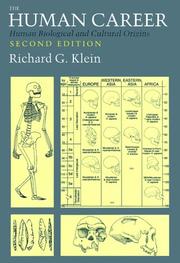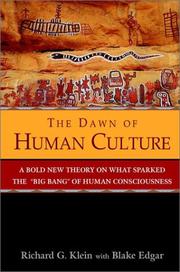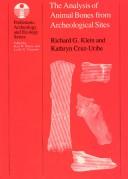| Listing 1 - 10 of 21 | << page >> |
Sort by
|
Book
ISBN: 9780226439655 0226439658 Year: 2009 Publisher: Chicago, Ill. The University of Chicago Press
Abstract | Keywords | Export | Availability | Bookmark
 Loading...
Loading...Choose an application
- Reference Manager
- EndNote
- RefWorks (Direct export to RefWorks)
Evolution. Phylogeny --- General palaeontology --- Prehistory --- Culture --- Fossil hominids. --- Human beings --- Human evolution. --- Origin.
Book
ISBN: 0226439453 Year: 1973 Publisher: Chicago : University of Chicago Press,
Abstract | Keywords | Export | Availability | Bookmark
 Loading...
Loading...Choose an application
- Reference Manager
- EndNote
- RefWorks (Direct export to RefWorks)
Paleolithic period --- Paléolithique --- Ukraine --- Antiquities --- Antiquités --- -Eolithic period --- Old Stone age --- Palaeolithic period --- Stone age --- -Antiquities --- -Ukraine --- Paléolithique --- Antiquités --- Eolithic period --- Antiquities.
Book
ISBN: 9061910978 9789061910978 Year: 1984 Publisher: Rotterdam ; Boston, MA : A.A. Balkema,
Abstract | Keywords | Export | Availability | Bookmark
 Loading...
Loading...Choose an application
- Reference Manager
- EndNote
- RefWorks (Direct export to RefWorks)
Prehistoric peoples --- Paleoecology --- Geology --- Geognosy --- Geoscience --- Earth sciences --- Natural history --- Palaeoecology --- Ecology --- Paleobiology --- Cavemen (Prehistoric peoples) --- Early man --- Man, Prehistoric --- Prehistoric archaeology --- Prehistoric human beings --- Prehistoric humans --- Prehistory --- Human beings --- Antiquities, Prehistoric --- Africa, Southern --- Southern Africa --- Antiquities. --- Paléoécologie --- Primitive societies --- Prehistoire et archeologie
Book
Year: 1984 Publisher: Rotterdam A.A. Balkema
Abstract | Keywords | Export | Availability | Bookmark
 Loading...
Loading...Choose an application
- Reference Manager
- EndNote
- RefWorks (Direct export to RefWorks)
AFS Southern Africa --- Southern Africa --- paleoecology --- prehistory
Book
ISBN: 0226439623 Year: 1989 Publisher: Chicago ; London : University of Chicago Press,
Abstract | Keywords | Export | Availability | Bookmark
 Loading...
Loading...Choose an application
- Reference Manager
- EndNote
- RefWorks (Direct export to RefWorks)
"The human career" chronicles the evolution of people from the earlisest primates, who lived perhaps 80 million years ago, through the emergency of fully modern humans within the past 200 thousand years. It is intended both for students and for anyone seeking a comprehention. It particularly stresses recent advances in knowledge, including, for example, exciting new evidence that fully modern humans originated in Africa and spread from there, displacing the Neanderthals and other archaic peoples in Europe and Asia. The author, Richard Klein, presents the evidence for conflicting opinions on this and other key issues, but does not hesitate to take positions. "The human career" is also innovative in its equal attention to both the fossil record and the archeological record over the 2,5 million-year interval for which both are available, emphasizing that human form and human behavior have evolved together. Klein shows that neglecting archeology in favor of the fossil record (or vice versa) inevitably limits our understanding of major human evolutionary events such as the time lag between the appearance of anatomically modern people in Africa and their eventual spread through Eurasia. Outlining broad developments in human evolution, Klein also introduces readers to the kinds of detailed data scholars use to document such developments. He presents information on archeological sties, artifacts, fossils, and methods for establishing dates in geological time, and he includes clearly labeled drawings that illustrate skeletal anatomy, stone artifacts, and stratigraphies. Detailed information on zoological classification and nomenclature and on stone tool typology and technology is provided in two appendixes.
Fossil hominids. --- Human beings --- Human evolution. --- Origin. --- Origine de l'homme --- Homme --- Hominidés fossiles --- Évolution --- Origine de l'homme. --- Hominidés fossiles. --- Évolution.

ISBN: 0226439631 Year: 1999 Publisher: Chicago University of Chicago press
Abstract | Keywords | Export | Availability | Bookmark
 Loading...
Loading...Choose an application
- Reference Manager
- EndNote
- RefWorks (Direct export to RefWorks)
Fossil hominids. --- Human beings --- Human evolution. --- Origin. --- Fossil hominids --- Human evolution --- Early man --- Fossil hominins --- Fossil man --- Hominids, Fossil --- Hominins, Fossil --- Human fossils --- Human remains (Archaeology) --- Primates, Fossil --- Paleoanthropology --- Evolution (Biology) --- Physical anthropology --- Evolutionary psychology --- Antiquity of human beings --- Origin of human beings --- Origin
Book
Year: 1974 Publisher: Cape Town South African Museum
Abstract | Keywords | Export | Availability | Bookmark
 Loading...
Loading...Choose an application
- Reference Manager
- EndNote
- RefWorks (Direct export to RefWorks)
Book
Year: 1973 Publisher: Chicago, London University of Chicago Press
Abstract | Keywords | Export | Availability | Bookmark
 Loading...
Loading...Choose an application
- Reference Manager
- EndNote
- RefWorks (Direct export to RefWorks)

ISBN: 0471252522 9780471252528 Year: 2002 Publisher: New York: Wiley,
Abstract | Keywords | Export | Availability | Bookmark
 Loading...
Loading...Choose an application
- Reference Manager
- EndNote
- RefWorks (Direct export to RefWorks)
Human evolution. --- Culture --- Homme --- Origin. --- Evolution --- Origines --- Culture - Origin.

ISBN: 0226439585 0226439577 9780226439587 Year: 1984 Publisher: Chicago, IL ; London : University of Chicago Press,
Abstract | Keywords | Export | Availability | Bookmark
 Loading...
Loading...Choose an application
- Reference Manager
- EndNote
- RefWorks (Direct export to RefWorks)
"After setting forth the interpretive framework that governs their use of numbers in faunal analysis, Richard G. Klein and Kathryn Cruz-Uribe survey various measures of taxonomic abundance, review methods for estimating the sex and age composition of a fossil species sample, and then give examples to show how these measures and sex/age profiles can provide useful information about the past. In the second part of their book, the authors present the computer programs used to calculate and analyze each numerical measure or count discussed in the earlier chapters. These elegant and original programs, written in BASIC, can easily be used by anyone with a microcomputer or with access to large mainframe computers"--Publisher.
Animal remains (Archaeology) --- Restes d'animaux (Archéologie) --- Analysis --- Data processing. --- Analyse --- Informatique --- Restes d'animaux (Archéologie) --- Archéozoologie --- Informatique. --- Analysis. --- Analyse informatique. --- PALEONTOLOGIE ANIMALE --- VERTEBRES
| Listing 1 - 10 of 21 | << page >> |
Sort by
|

 Search
Search Feedback
Feedback About UniCat
About UniCat  Help
Help News
News